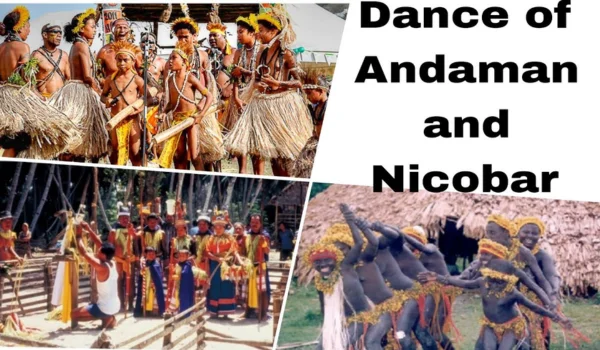The Andaman and Nicobar Islands, an archipelago located in the Bay of Bengal, are home to a diverse range of tribal communities, each with its own unique cultural traditions, music, and dance forms. The traditional dances of these islands are deeply influenced by nature, tribal rituals, folklore, and social life. These dances serve as a form of expression, storytelling, and spiritual practice, connecting the indigenous people with their ancestors and the environment.
The islands are inhabited by both indigenous tribes (such as the Great Andamanese, Onges, Jarwas, Shompens, and Sentinalese) and settlers from mainland India, leading to a blend of tribal and mainland dance forms. However, the indigenous dances remain unique and deeply rooted in the tribal way of life.
In this article, we explore some of the most famous traditional dance forms of Andaman and Nicobar Islands, their origins, significance, and cultural importance.

1. Nicobari Dance
The Nicobari Dance is the most popular folk dance of the Nicobar Islands, performed by the Nicobari tribe. It is primarily performed during the Ossuary Feast (Pig Festival), which honors deceased tribal chiefs.
Features:
- The dance is performed in circular formations, symbolizing unity and social harmony.
- It involves gentle swaying movements, synchronized hand gestures, and rhythmic stepping.
- It represents community bonding, gratitude for nature, and respect for ancestors.
- Men and women participate in the dance, often accompanied by folk singing and traditional music.
Costume & Music:
- Dancers wear simple tribal attire made of coconut leaves, grass skirts, and ornaments made of shells and beads.
- The music consists of drumming, clapping, and folk songs, creating a calm and harmonious atmosphere.
2. Canoe Dance
The Canoe Dance is a traditional dance form of the Nicobarese people, performed during important tribal ceremonies and feasts. This dance represents the importance of the sea and fishing in their culture.
Features:
- Dancers imitate rowing movements, symbolizing their connection to the sea.
- The dance is performed in groups, moving rhythmically to the beats of tribal drums.
- It depicts fishing expeditions, canoe journeys, and adventures on the ocean.
Costume & Music:
- Performers wear traditional Nicobari dresses with ornaments made of seashells and coconut fibers.
- The music consists of drums, wooden percussion instruments, and rhythmic chanting.
3. Andamanese Tribal Dance
The Great Andamanese tribe, one of the oldest indigenous communities of the islands, has a rich tradition of dance and music.
Features:
- It is performed during tribal gatherings, hunting celebrations, and seasonal festivals.
- The dance includes vigorous foot movements, jumping, and synchronized clapping.
- It often represents hunting scenes, warfare, and storytelling through expressive body movements.
Costume & Music:
- The dancers wear minimalistic tribal clothing made of leaves, tree bark, and natural fibers.
- The music consists of rhythmic drumming, chanting, and traditional songs praising nature and ancestors.
4. Onges Dance
The Onges, a semi-nomadic tribe of the Little Andaman Island, perform traditional dances that are deeply spiritual and ritualistic.
Features:
- The dance is performed in circular formations around a fire, often as part of ritualistic ceremonies and seasonal festivals.
- It is slow and graceful, reflecting the tribal way of life and their respect for the environment.
- The movements symbolize prayers to spirits, gratitude for nature, and blessings for hunting and fishing.
Costume & Music:
- The Onges wear loincloths made of tree bark and natural fibers.
- The music includes drumming, humming, and tribal songs passed down through generations.
5. Shompens Dance
The Shompens, a reclusive and nomadic tribe living in Nicobar’s dense forests, have their own unique dance traditions.
Features:
- Their dance is inspired by nature, animals, and hunting rituals.
- It includes fast-paced steps, dramatic movements, and expressive gestures.
- The dance is often performed before or after a successful hunt.
Costume & Music:
- Dancers wear simple garments made of leaves and animal skin.
- The music is minimal, relying on natural sounds, chanting, and occasional drumming.
6. Bompoka Dance
Bompoka dance is performed by the Nicobarese community, especially during celebrations and village festivals.
Features:
- The dance is energetic and lively, with participants moving in quick rhythmic patterns.
- It is often performed in a group with dancers holding hands or forming a chain.
- The movements symbolize happiness, social unity, and festive joy.
Costume & Music:
- Performers wear colorful traditional Nicobari attire, including woven skirts and feathered headgear.
- The music consists of tribal percussion instruments and folk singing.
7. Chug Dance
The Chug dance is performed by various tribes in the Nicobar Islands, particularly during weddings and social celebrations.
Features:
- It is a group dance with synchronized movements.
- The dance is fast-paced and joyful, symbolizing harmony and love.
- It is performed during weddings, birth ceremonies, and tribal gatherings.
Costume & Music:
- Dancers wear tribal skirts and jewelry made from natural materials like shells and seeds.
- The music consists of hand clapping, drum beats, and vocal folk songs.
Conclusion
The traditional dances of Andaman and Nicobar Islands are a reflection of the tribal communities’ deep connection with nature, spirituality, and social life. From the graceful Nicobari Dance to the energetic Bompoka Dance, and from the ritualistic Onges Dance to the adventurous Canoe Dance, each dance form has a unique identity and cultural significance.
These dances are not just a source of entertainment but also ritualistic expressions, storytelling tools, and social bonding activities. With modernization and tourism influencing the islands, there is a growing need to preserve these indigenous dance traditions and ensure that the rich cultural heritage of Andaman and Nicobar Islands continues to thrive.

Hello, I’m Kapil Kumar, a seasoned SEO expert and blogger at WinnersList.in. My mission is to spotlight exceptional individuals and organizations across various domains. Through curated lists, profiles, and inspiring stories, I aim to celebrate outstanding achievements and inspire the next generation of champions. Join me in this journey.
